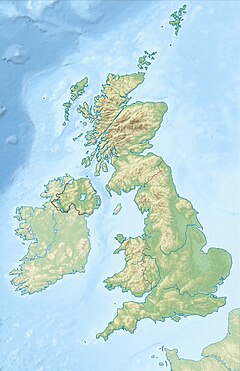Mullard Radio Astronomy Observatory
 | |
| Named after | Mullard |
|---|---|
| Location | United Kingdom |
| Coordinates | 52°10′03″N 0°01′57″E / 52.1674°N 0.0326°E |
| Telescopes | |
| | |

The Mullard Radio Astronomy Observatory (MRAO) is located near Cambridge, UK and is home to a number of the largest and most advanced aperture synthesis radio telescopes in the world, including the One-Mile Telescope, 5-km Ryle Telescope, and the Arcminute Microkelvin Imager. It was founded by the University of Cambridge and is part of the Cambridge University, Cavendish Laboratories, Astrophysics Department.
History
[edit]Radio interferometry started in the mid-1940s on the outskirts of Cambridge, but with funding from the Science Research Council and a corporate donation of £100,000 from Mullard Limited, a leading commercial manufacturer of thermionic valves.
Construction of the Mullard Radio Astronomy Observatory commenced at Lords Bridge Air Ammunition Park,[1] a few kilometres to the west of Cambridge.
The observatory was founded under Martin Ryle of the Radio-Astronomy Group of the Cavendish Laboratory, University of Cambridge and was opened by Sir Edward Victor Appleton on 25 July 1957. This group is now known as the Cavendish Astrophysics Group.
Location
[edit]The observatory is located a few miles south-west of Cambridge at Harlton on a former ordnance storage site, next to the disused Oxford-Cambridge Varsity railway line.
A portion of the track bed of the railway, running nearly east-west for several miles, was used to form the main part of the "5km" radio-telescope and the Cambridge Low Frequency Synthesis Telescope. Due to this, the reconstruction of the railway line between Oxford and Cambridge will follow a new alignment at this point.
Telescopes
[edit]| Telescope | Year built | Status |
|---|---|---|
| Arcminute Microkelvin Imager Large Array | 2007 | Active |
| Arcminute Microkelvin Imager Small Array | 2004 | |
| Very Small Array (moved to Tenerife in 1999) | 1998 | |
| Cosmic Anisotropy Telescope made first high-resolution maps of Cosmic Microwave Background fluctuations | 1995 | Decommissioned |
| Cambridge Optical Aperture Synthesis Telescope (COAST) first aperture synthesis at optical wavelengths | 1993 | Operated on clear nights |
| One receiver from the e-MERLIN array | 1990 | Active |
| Cambridge Low Frequency Synthesis Telescope (CLFST) | 1980 | Decommissioned |
| Ryle Telescope (formerly 5-Kilometre Telescope) | 1971 | Decommissioned (repurposed for AMI LA in 2006) |
| Half-Mile Telescope | 1968 | Decommissioned |
| Interplanetary Scintillation Array discovered first pulsar | 1967 | |
| One-Mile Telescope | 1964 | |
| 4C Array, first telescope at the Cambridge's new observatory, used to make the 4C catalogue | 1958 |
Gallery
[edit]The following photographs (except for the last 2 items) were taken in June 2014:
- Platform and Lecture Room formerly part of Lord's Bridge Railway Station
- Arcminute Microkelvin Imager - Large Array (AMI-LA)
- Arcminute Microkelvin Imager - Small Array (AMI-SA)
- Stitched panorama of the Cosmic Anisotropy Telescope enclosure
- Part of the Cambridge Optical Aperture Synthesis Telescope
- The interior of the bunker of the Cambridge Optical Aperture Synthesis Telescope
- The receiver from the e-MERLIN array
- Surviving Yagi antennas of the Cambridge Low Frequency Synthesis Telescope
- Two Half-Mile Telescopes
- Remains of the Interplanetary Scintillation Array
- One-Mile Telescope (left), two of the Half-Mile Telescope (centre) and the remains of the 4C Array (right)
- Remains of the 4C Array, with One-Mile Telescope in the background
- Mullard EL34 Power Pentode. Mullard produced up to 40% of thermionic valves used by Britain during 1939-1945 War
- Mullard Radio Astronomy Observatory plaque


 French
French Deutsch
Deutsch












